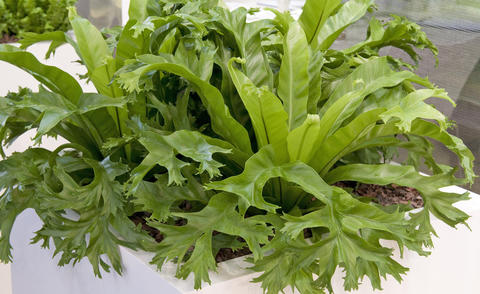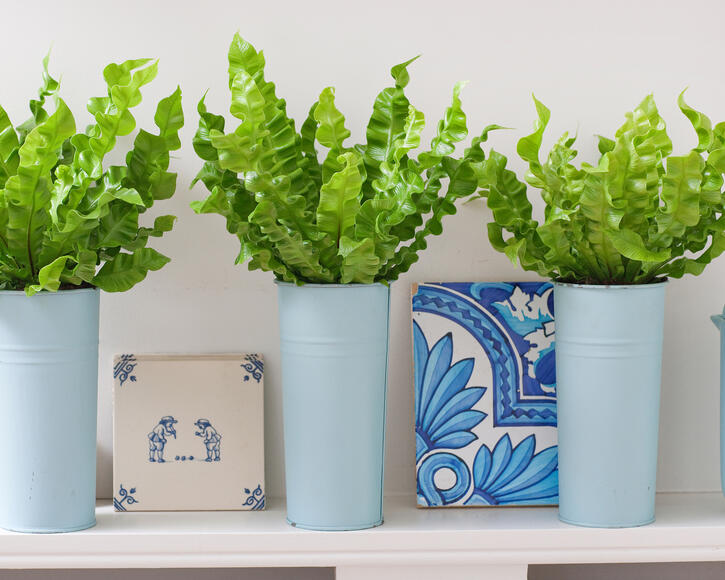Bird’s Nest Fern
It can be a bit tricky to cultivate Bird’s Nest Ferns - but it’s worth it. You can find tips on planting and caring for the tropical houseplant here.
Factsheet
- Growth type
-
- Fern
- Growth height (from)
- from 90 cm to 100 cm
- Growth characteristics
-
- sweeping
- upright
- overhanging
- Leaf color
-
- green
- page format
-
- lancéolées
- Sheet properties
-
- Rosette
- Light
-
- scattered light to semi-shade
- Soil type
-
- sandy to loamy
- Soil Moisture
-
- humid
- ph value
-
- neutral to weakly acidic
- Lime compatibility
-
- lime-tolerant
- Nutrient requirements
-
- nutrient-rich
- Humus
-
- rich in humus
- Decorative or utility value
-
- Leaf ornaments
- Use
-
- Interior greening
- Planters
- Winter garden
- Garden style
-
- Pot garden
The Bird’s Nest Fern (Asplenium nidus) from the Aspleniaceae family is a popular houseplant and provides fresh greenery in the house with its unique leafy crown. It is native to the tropical regions of Africa, Asia, and Australia, where it grows as a stately epiphyte on trees.
As a houseplant, the evergreen bird’s nest fern also reaches a decent height and grows between 35.43 and 39.37 inches tall. Initially, it grows straight upright, but over time it’s long leaves hang over expansively.
Bird’s Nest Fern leaves are arranged in a basal, trumpet-shaped rosette and protrude upright in height. They are lanceolate and slightly to very wavy. Similarly to many large-leaved species, the bird’s nest fern also has an air cleaning effect and demonstrably improves the room climate.
The Bird’s Nest Fern is a purely leaf ornamentation plant and does not form flowers.
Asplenium nidus propagates itself through spores. These develop into groups of spore stores (sori) on the underside of the leaves and run along the right and left side of the central vein in straight rows.

The Bird’s Nest Fern is quite sensitive about its location in the house. The location should...
- be semi-shady and out of direct sunlight,
- have increased air humidity of at least 60 percent,
- be protected against drafts, and
- have a constant temperature between 68 and 77 degrees Fahrenheit all year round (never below 64.4 degrees Fahrenheit).
Provided the other location conditions are suitable, the bird’s nest fern can also manage with lower humidity. However, it the air is much too dry, it reacts by developing unattractive, brown leaf margins.
Humus-rich standard soil with a pH value of 5 provides the bird’s nest fern with the perfect growing conditions. For better drainage, you should fill the bottom of the pot with a layer of gravel or .
As a tropical plant, the Bird’s Nest Fern should be constantly in moist conditions, but never in the wet. Water should be at room temperature and as low in calcium as possible.

The Bird’s Nest Fern does not require additional fertilizing for the first year after repotting, as it draws all the necessary nutrients from its substrate. Afterwards, it is fertilized every two weeks from April to September with liquid green plant fertilizer in half dosage. As there is no natural resting phase for the Bird’s Nest Fern when it is cultivated indoors, you can also fertilize it for the other half of the year in a six week rhythm; however, this is not essential.
A new pot is only required every two to three years on average. The best time for repotting is in the summer. It is sufficient for the new plant container to be only a few inches larger than the previous one.
The Bird’s Nest Fern does not require pruning. Quite the opposite: Pruning can deform the even leaf tubes, which then remain unsightly for a long time, as Asplenium nidus only grows slowly. However, dried fronds can be removed close to the base.

In addition to the species, only a few varieties of bird’s nest fern are available. Asplenium nidus ‘Crissie’ looks particularly bizarre: its leaf fronds fray at the tips.
The Bird’s Nest Fern is propagated through spores and may be difficult for non-experts. Do this by cutting a leaf in summer and drying it for several days, until the spores on the underside of the leaf fall off. Then spread these on low-nutrient potting soil and keep permanently moist under film or glass. A constant temperature of 71.6 degrees Fahrenheit is required for several weeks for the Bird’s Nest Fern to form roots.
The Bird’s Nest Fern is actually very robust and long-lasting. It is generally cultivation mistakes that lead to a premature end for this houseplant. However, in the event of an infestation with Aphelenchoides or nematodes, the plant generally cannot be saved. The damage shows itself as brown discoloration on the leaves.

